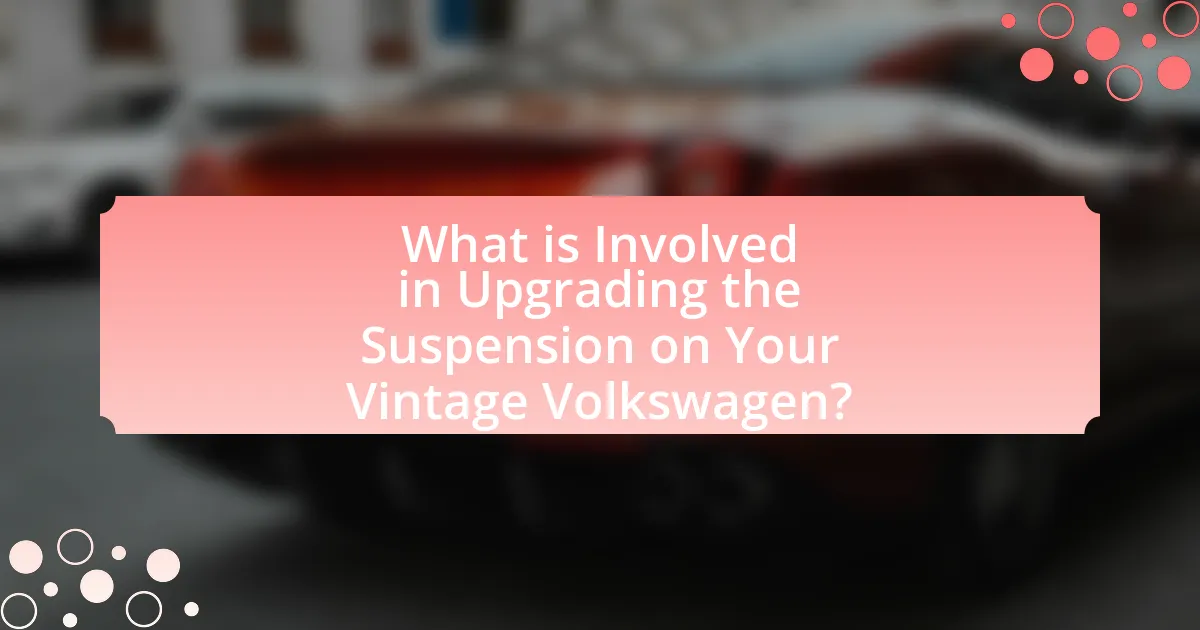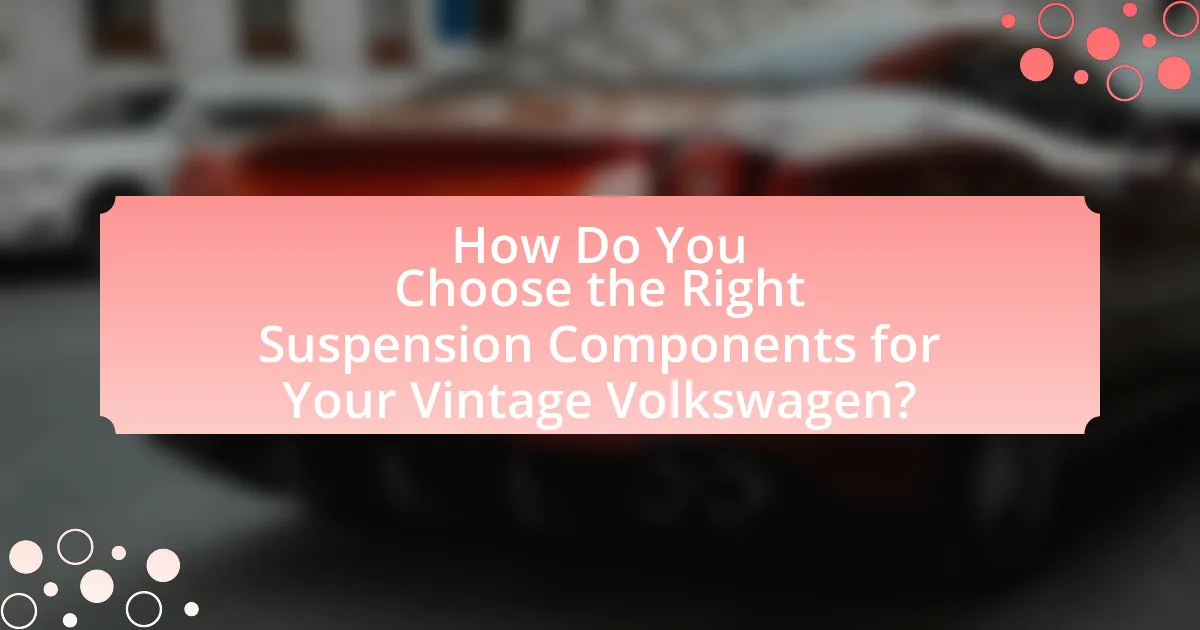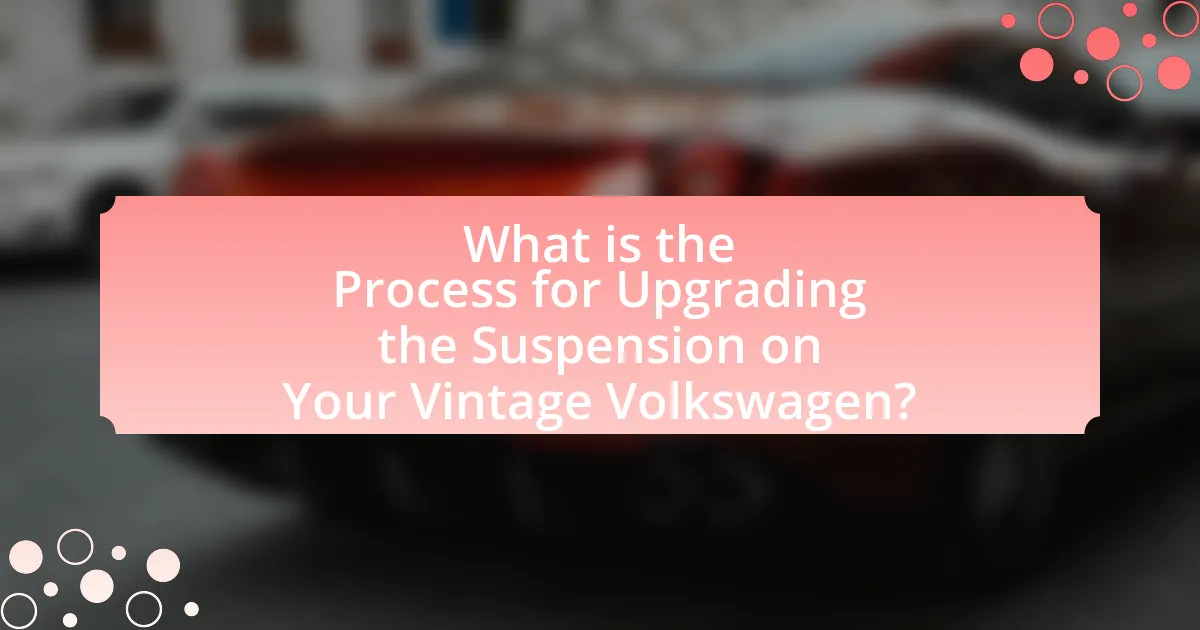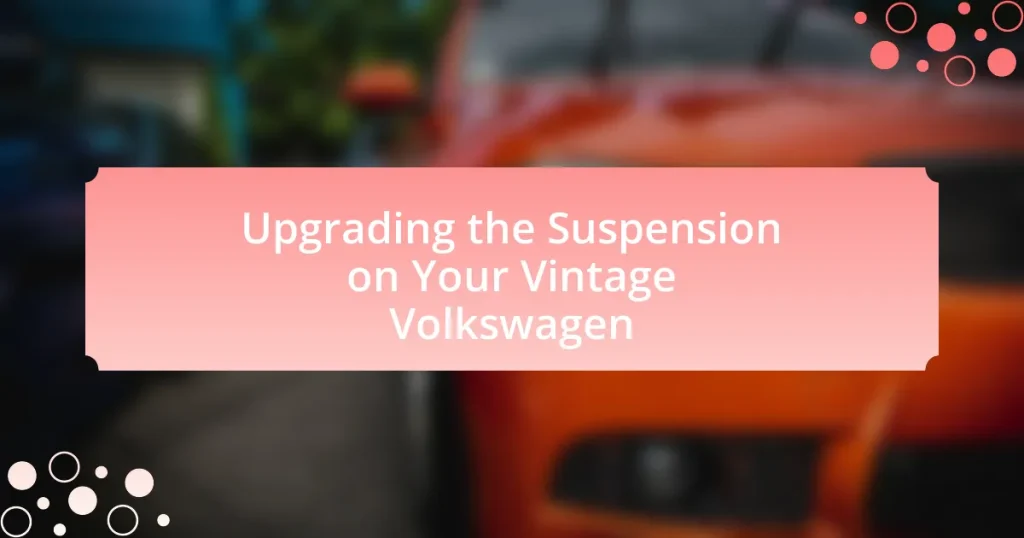Upgrading the suspension on a vintage Volkswagen involves replacing or modifying existing components to enhance handling, ride quality, and overall performance. Key aspects include selecting compatible shock absorbers, springs, and sway bars, as well as adjusting suspension geometry for proper alignment. The article addresses the importance of suspension upgrades for improving safety and comfort, common issues with stock systems, and various upgrade options such as coilovers and air suspension. It also outlines the process for upgrading, including necessary tools, installation steps, and maintenance practices to ensure longevity and optimal performance of the upgraded suspension system.

What is Involved in Upgrading the Suspension on Your Vintage Volkswagen?
Upgrading the suspension on your vintage Volkswagen involves replacing or modifying the existing suspension components to improve handling, ride quality, and overall performance. This process typically includes selecting new shock absorbers, springs, and possibly sway bars that are compatible with the specific model of Volkswagen, such as the Beetle or Bus.
The upgrade may also require adjusting or replacing the suspension geometry to accommodate the new components, ensuring proper alignment and clearance. Additionally, installation may involve specialized tools and techniques, such as spring compressors and alignment equipment, to ensure safety and effectiveness.
Research indicates that upgrading suspension can enhance vehicle stability and comfort, with studies showing improved handling characteristics in modified vehicles.
Why is upgrading the suspension important for vintage Volkswagens?
Upgrading the suspension is important for vintage Volkswagens because it enhances ride quality, handling, and safety. Vintage Volkswagens often come with outdated suspension systems that may not provide adequate support or stability, leading to a less comfortable driving experience. Improved suspension components can reduce body roll, increase traction, and enhance overall vehicle control, making the car safer to drive. Additionally, modern suspension upgrades can accommodate contemporary driving conditions and road surfaces, which differ significantly from those when these vehicles were originally manufactured.
What are the common issues with stock suspension systems in vintage Volkswagens?
Common issues with stock suspension systems in vintage Volkswagens include inadequate ride quality, poor handling, and limited adjustability. These vehicles often feature outdated technology, such as leaf springs and rigid axles, which can lead to a harsh ride and reduced stability during cornering. Additionally, worn-out components like bushings and shocks can exacerbate these problems, resulting in excessive body roll and diminished comfort. Historical data indicates that many vintage Volkswagen owners report these issues as significant drawbacks, prompting upgrades to modern suspension systems for improved performance and safety.
How does suspension upgrade improve ride quality and handling?
A suspension upgrade improves ride quality and handling by enhancing the vehicle’s ability to absorb road imperfections and maintain tire contact with the road surface. Upgraded components, such as shocks, struts, and springs, are designed to provide better damping characteristics, which reduces body roll during cornering and improves stability. For example, high-performance shock absorbers can adjust to varying road conditions more effectively, leading to a smoother ride and increased traction. Studies have shown that vehicles with upgraded suspension systems experience a significant reduction in vibrations and improved steering response, contributing to overall better handling and comfort.
What types of suspension upgrades are available for vintage Volkswagens?
Various suspension upgrades are available for vintage Volkswagens, including lowering kits, adjustable coilovers, and upgraded shock absorbers. Lowering kits typically consist of shorter springs that reduce ride height, enhancing aesthetics and handling. Adjustable coilovers allow for customization of ride height and damping settings, providing flexibility for different driving conditions. Upgraded shock absorbers improve ride quality and handling performance by better managing suspension movement. These upgrades are widely recognized in the vintage Volkswagen community for enhancing both performance and comfort.
What are the differences between coilover and shock absorber upgrades?
Coilover upgrades combine a shock absorber and a coil spring into a single unit, allowing for adjustable ride height and improved handling, while shock absorber upgrades focus solely on enhancing the damping characteristics of the suspension without altering ride height. Coilovers provide more customization options for performance tuning, making them suitable for enthusiasts seeking specific handling characteristics, whereas shock absorbers are typically easier to install and may be preferred for those looking for a straightforward improvement in ride quality. The versatility of coilovers is evidenced by their widespread use in motorsports and performance vehicles, where precise handling is crucial, while shock absorbers are commonly used in standard vehicle upgrades for enhanced comfort and stability.
How do air suspension systems compare to traditional setups?
Air suspension systems provide a more adjustable and smoother ride compared to traditional setups, which typically use coil or leaf springs. Air suspension allows for varying ride heights and improved load leveling, enhancing comfort and handling, especially on uneven surfaces. In contrast, traditional setups offer a fixed ride height and may not adapt as effectively to changing loads or road conditions. Studies indicate that vehicles equipped with air suspension can achieve better traction and stability, particularly in performance scenarios, due to the ability to fine-tune the suspension characteristics.
What factors should you consider before upgrading the suspension?
Before upgrading the suspension on your vintage Volkswagen, consider the vehicle’s intended use, budget, and compatibility with existing components. The intended use, whether for daily driving, off-roading, or show purposes, will dictate the type of suspension system needed. Budget constraints will influence the quality and type of suspension parts you can afford, as high-performance options can be significantly more expensive. Compatibility with existing components is crucial, as certain upgrades may require additional modifications or replacements of other parts to ensure proper functionality and safety.
How does your driving style influence the choice of suspension upgrade?
Your driving style significantly influences the choice of suspension upgrade by determining the balance between comfort and performance. For instance, aggressive driving styles that involve high-speed cornering and rapid acceleration typically require stiffer suspension systems to enhance handling and reduce body roll. Conversely, a more relaxed driving style prioritizes comfort, leading to a preference for softer suspension setups that absorb bumps and provide a smoother ride. Research indicates that performance-oriented upgrades, such as coilovers or sport shocks, are favored by drivers seeking improved responsiveness, while those focused on daily driving may opt for upgraded stock components that maintain comfort without sacrificing too much performance.
What is the impact of suspension upgrades on vehicle aesthetics?
Suspension upgrades significantly enhance vehicle aesthetics by altering the stance and overall appearance of the vehicle. These upgrades often lower or raise the vehicle’s height, which can create a more aggressive or sporty look, appealing to enthusiasts. For instance, lowering a vintage Volkswagen can improve its visual profile, making it appear more streamlined and modern. Additionally, upgraded suspension components, such as performance shocks and springs, can provide a polished look that complements custom wheels and body modifications. This transformation not only improves aesthetics but also aligns with the preferences of car enthusiasts who value both performance and style.

How Do You Choose the Right Suspension Components for Your Vintage Volkswagen?
To choose the right suspension components for your vintage Volkswagen, assess your driving style, intended use, and desired ride quality. Vintage Volkswagens often require specific components that match their original specifications or enhance performance without compromising comfort. For example, if you plan to use your vehicle for daily driving, consider components that provide a balance between comfort and handling, such as adjustable shocks and upgraded springs. If you aim for performance, look for stiffer springs and performance shocks designed for better handling. Additionally, ensure compatibility with your vehicle’s model year and specifications, as suspension components can vary significantly across different models. Researching reputable brands and consulting with vintage Volkswagen forums or specialists can provide insights into the best options available, ensuring that your choices enhance both safety and driving experience.
What are the key components to consider when selecting suspension parts?
When selecting suspension parts for a vintage Volkswagen, key components to consider include compatibility, material quality, adjustability, and performance characteristics. Compatibility ensures that the parts fit the specific model and year of the Volkswagen, as different models may have unique suspension requirements. Material quality is crucial for durability and performance; high-grade materials like aluminum or reinforced steel can enhance longevity and reduce weight. Adjustability allows for customization of ride height and stiffness, which can improve handling and comfort based on personal preferences or driving conditions. Performance characteristics, such as damping rates and spring rates, directly affect ride quality and vehicle handling, making it essential to choose parts that align with the desired driving experience.
How do spring rates affect the performance of your suspension?
Spring rates directly influence the performance of your suspension by determining how much weight the springs can support and how they respond to road conditions. A higher spring rate results in a stiffer suspension, which can improve handling and reduce body roll during cornering, but may also lead to a harsher ride. Conversely, a lower spring rate provides a softer suspension, enhancing comfort and absorbing bumps better, but can compromise handling stability. Research indicates that optimal spring rates are crucial for achieving a balance between comfort and performance, as evidenced by studies showing that vehicles with properly matched spring rates exhibit improved traction and stability under various driving conditions.
What role do dampers play in suspension performance?
Dampers play a crucial role in suspension performance by controlling the rate of oscillation and providing stability to the vehicle. They achieve this by dissipating energy generated from road irregularities, which helps to minimize excessive bouncing and swaying. This control enhances ride comfort and handling, ensuring that the tires maintain better contact with the road surface. Research indicates that effective dampers can significantly improve vehicle dynamics, as evidenced by studies showing that vehicles equipped with high-quality dampers exhibit reduced body roll and improved cornering stability.
How can you ensure compatibility with your vintage Volkswagen model?
To ensure compatibility with your vintage Volkswagen model, you should verify that any suspension components you consider for upgrading are specifically designed for your model year and type. Vintage Volkswagens, such as the Beetle or Bus, have unique specifications that vary across different production years, making it essential to consult manufacturer guidelines or trusted aftermarket suppliers who specialize in vintage parts. For instance, using parts that are compatible with a 1967 Beetle may not work for a 1974 model due to differences in design and dimensions. Additionally, cross-referencing with forums or communities dedicated to vintage Volkswagen enthusiasts can provide insights and recommendations on compatible upgrades, ensuring that the suspension system maintains the vehicle’s original handling characteristics and safety standards.
What resources are available for finding compatible suspension parts?
Online marketplaces such as eBay and Amazon provide extensive listings for compatible suspension parts for vintage Volkswagens. These platforms allow users to filter search results by vehicle make, model, and year, ensuring that the parts are suitable for specific vintage Volkswagen models. Additionally, specialized automotive websites like Aircooled.net and TheSamba.com offer forums and classified sections where enthusiasts can buy, sell, or trade suspension components tailored for vintage Volkswagens. These resources are validated by the active participation of the vintage Volkswagen community, which frequently shares experiences and recommendations regarding parts compatibility.
How do aftermarket parts differ from OEM components?
Aftermarket parts differ from OEM components primarily in their manufacturing source and quality standards. OEM components are produced by the original equipment manufacturer and are designed to meet specific standards set by the vehicle manufacturer, ensuring compatibility and reliability. In contrast, aftermarket parts are made by third-party companies and can vary widely in quality, performance, and fit. Some aftermarket parts may offer enhancements or cost savings, while others may not meet the same quality benchmarks as OEM parts, potentially affecting vehicle performance and safety.

What is the Process for Upgrading the Suspension on Your Vintage Volkswagen?
The process for upgrading the suspension on your vintage Volkswagen involves several key steps. First, assess the current suspension system to determine the specific upgrades needed, such as replacing shocks, springs, or adding sway bars. Next, gather the necessary tools and parts, which may include aftermarket suspension kits designed for vintage models.
Once you have the parts, lift the vehicle securely using jack stands to ensure safety. Remove the existing suspension components, taking care to document the order of disassembly for reinstallation. Install the new suspension parts according to the manufacturer’s instructions, ensuring all bolts are tightened to the specified torque settings.
Finally, perform a wheel alignment to ensure proper handling and tire wear. This process is validated by numerous automotive restoration guides that emphasize the importance of safety and precision in suspension upgrades for vintage vehicles.
What tools and materials do you need for the suspension upgrade?
To upgrade the suspension on your vintage Volkswagen, you need specific tools and materials including a jack, jack stands, wrenches, sockets, a torque wrench, and replacement suspension components such as shocks, struts, springs, and bushings. These tools allow for safe lifting and secure fastening of the suspension parts, while the materials ensure improved handling and ride quality. The use of a torque wrench is critical for applying the correct tension to bolts, which is essential for safety and performance.
How do you prepare your workspace for the upgrade process?
To prepare your workspace for the upgrade process, first ensure that you have a clean, organized area with adequate lighting and ventilation. This setup minimizes the risk of accidents and allows for efficient work. Next, gather all necessary tools and materials, such as wrenches, jacks, and replacement parts, to avoid interruptions during the upgrade. Additionally, having a designated space for storing removed components helps maintain order. Proper preparation reduces the likelihood of errors and enhances the overall efficiency of the suspension upgrade on your vintage Volkswagen.
What safety precautions should you take during the upgrade?
During the upgrade of the suspension on your vintage Volkswagen, it is essential to take several safety precautions to ensure a safe and effective process. First, always work on a flat, stable surface to prevent the vehicle from rolling or tipping over. Second, use jack stands to support the vehicle securely after lifting it with a jack, as relying solely on a jack can lead to accidents. Third, wear appropriate personal protective equipment, such as gloves and safety glasses, to protect against injuries from sharp components or debris. Additionally, disconnect the battery to avoid electrical hazards while working on the suspension system. Following these precautions minimizes risks and enhances safety during the upgrade process.
What are the step-by-step instructions for upgrading the suspension?
To upgrade the suspension on your vintage Volkswagen, follow these step-by-step instructions:
- Gather necessary tools and parts, including a jack, jack stands, wrenches, and the new suspension components.
- Safely lift the vehicle using the jack and secure it with jack stands to ensure stability.
- Remove the wheels to access the suspension components.
- Disconnect the old suspension parts, including shocks, struts, and springs, by unbolting them from their mounting points.
- Install the new suspension components by following the manufacturer’s instructions, ensuring all bolts are tightened to the specified torque.
- Reattach the wheels and lower the vehicle back to the ground.
- Test the suspension by taking the vehicle for a short drive to ensure proper functionality.
These steps are based on standard practices for suspension upgrades, which emphasize safety and adherence to manufacturer specifications.
How do you remove the old suspension components?
To remove the old suspension components from a vintage Volkswagen, first, lift the vehicle securely using jack stands to ensure safety. Next, detach the wheels to access the suspension system. Then, remove the bolts securing the suspension components, such as the control arms, shocks, and springs, using appropriate tools like a socket wrench. It is essential to support the components as they are removed to prevent injury or damage. Finally, carefully extract the old components from their mounts. This method is effective as it follows standard automotive repair practices, ensuring that the removal process is safe and efficient.
What is the correct way to install new suspension parts?
To install new suspension parts correctly, begin by safely lifting the vehicle and securing it on jack stands. Next, remove the old suspension components, ensuring to document the order of disassembly for reference. Install the new suspension parts by following the manufacturer’s specifications, which typically include aligning the components properly and tightening bolts to the recommended torque settings. Finally, double-check all connections and perform a test drive to ensure proper functionality. This method is validated by automotive repair guidelines that emphasize safety and precision in suspension work.
What common challenges might you face during the upgrade?
Common challenges during the upgrade of a vintage Volkswagen suspension include compatibility issues, sourcing quality parts, and potential modifications to the vehicle’s frame. Compatibility issues arise when new suspension components do not fit existing mounts or align with the vehicle’s specifications, which can lead to additional costs and time delays. Sourcing quality parts can be difficult due to the limited availability of vintage components, often requiring extensive research or reliance on specialized suppliers. Additionally, modifications to the vehicle’s frame may be necessary to accommodate new suspension systems, which can complicate the installation process and require advanced mechanical skills.
How can you troubleshoot issues that arise during installation?
To troubleshoot issues that arise during the installation of a suspension upgrade on a vintage Volkswagen, first, ensure that all components are compatible with the specific model and year of the vehicle. Verify that the installation instructions are followed precisely, as deviations can lead to improper fitment or functionality. If problems persist, check for common issues such as misalignment, missing hardware, or inadequate torque specifications on bolts, as these factors can significantly affect performance and safety. Additionally, consulting forums or guides specific to vintage Volkswagen upgrades can provide insights from others who have faced similar challenges, reinforcing the troubleshooting process with practical experiences.
What should you do if parts do not fit as expected?
If parts do not fit as expected during the suspension upgrade on your vintage Volkswagen, you should first verify that you have the correct parts for your specific model. This involves checking part numbers and compatibility specifications. If the parts are indeed correct but still do not fit, you should assess whether any modifications are necessary, such as adjusting mounting points or using spacers. Additionally, consulting the installation manual or seeking advice from a professional mechanic can provide guidance on resolving fitment issues. Accurate fitment is crucial, as improper installation can lead to safety hazards and performance issues.
What are the best practices for maintaining your upgraded suspension?
To maintain your upgraded suspension effectively, regularly inspect and clean all components, including shocks, struts, and bushings, to prevent dirt and debris buildup. Additionally, ensure proper alignment and adjust the suspension settings according to the manufacturer’s specifications to optimize performance. Regularly check for signs of wear, such as leaks or unusual noises, and replace any worn parts promptly to maintain safety and handling. Following these practices can extend the lifespan of your suspension system and enhance the driving experience.
How often should you inspect your suspension components?
You should inspect your suspension components every 6,000 to 12,000 miles or at least once a year. Regular inspections help identify wear and tear, ensuring safety and performance. According to the Automotive Maintenance and Repair Association, neglecting suspension maintenance can lead to decreased vehicle handling and increased repair costs.
What maintenance tasks are essential for longevity of the suspension system?
Regular inspection and maintenance of the suspension system are essential for its longevity. Key tasks include checking and replacing worn-out bushings, inspecting shock absorbers for leaks or damage, and ensuring proper alignment of the wheels. Additionally, lubricating moving parts and examining the springs for signs of wear can prevent premature failure. These maintenance practices help maintain optimal performance and extend the lifespan of the suspension components, as evidenced by automotive studies indicating that regular upkeep can significantly reduce the risk of suspension-related issues.

